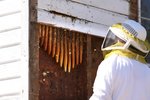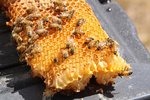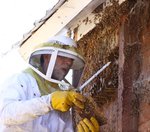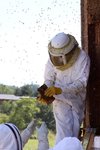



They assemble, each arriving in his own vehicle, and begin pulling on their white protective suits. Their mission — to rid the building of its invasive horde.
VIDEO
Honeybees, a massive colony, have taken up residence in the exterior wall of the old Salzer Valley Schoolhouse.
Bob Harris, Jason Sherwood, Norm Switzler, and Dave, a retired man from Pe Ell whom everyone simply refers to as the “Bee Guy” — these local bee enthusiasts are part of the “Bee Recovery Team,” a casual group of the more active members of the Lewis County Beekeepers Association.
This job, the careful removal and relocation of more than 100,000 Russian-Italian hybrid honeybees, has become a routine part of the group’s summer.
“This time of year, I’m getting three to five calls per day,” says Harris, a retired military man living on a small family farm, the Rose of Sharon, in Chehalis. “Seventy-five percent of them I handle with advice, the other 25 percent is going to somebody’s house or business and doing a removal of some kind.”
These Salzer Valley bees were collected Sunday afternoon and moved early Monday to boxes in Pe Ell, where hobby beekeepers from the local association will care for them, feeding the hive its own honey over the winter and allowing the brood (eggs) collected from the schoolhouse to hatch next year.
Salzer Valley is an old farming community just southeast of Centralia. The original schoolhouse was built in the late 1800s.
Today the 20 or so members of the Salzer Valley Community Club are trying to maintain the building, which remained an important meeting place for the community into the 1970s and ’80s.
Carla Osterby, a community club member, said the club’s current project is to install a new foundation under the original building.
“But first things first, the bees need a new address,” Osterby said.
The club didn’t want to exterminate the large colony of helpful insects. Most people are aware of recent news about vanishing honeybees in this country and the mysterious theory of Colony Collapse Disorder.
Though Lewis County seems not to have been much affected yet by this unknown threat to honeybees, according to Harris, people are still concerned.
But Osterby said the hive had been there for several years, and the building has a history of attracting the things.
“Seems to me there’s always been bees there,” Osterby said. “Hopefully this time we’ll win the battle.”
Several members of the community club made up the small crowd outside the schoolhouse in the afternoon heat Sunday as the Bee Recovery Team cut out, chunk by chunk, a hive that measured maybe two feet by seven feet.
The beekeepers had globs of irritated, buzzing bees spotting their bright white suits. One man worked at extracting the chunks of hive while the others collected the honey and populated the hive boxes they had brought.
They worked carefully and slowly, trying to upset the creatures as little as possible. Dave “the Bee Guy” reported that the team successfully removed the queen and eight frames of brood.
By early Monday morning, when Dave returned to collect the quieted adult bees, the ball of slumbering insects weighed about 10 pounds.
Bees may seem pesky little winged insects, and many people fear their sharp sting and venom, but no one can deny that without bees we would be in trouble.
“Virtually everything that a person eats is impacted by pollinators,” said Harris, who is also president of the beekeepers association. “There’s moths, ants, earwigs, but predominately the bulk of the work is done by bees. They’re pretty darn critical to the ecosystem and the food supply.”
Harris and the other members of the association are mostly hobbyist beekeepers, doing it out of a kind of scientific curiosity and gentle reverence for the fascinating insects. They make little money from honey sales, but they find the care and tending of bees satisfying nonetheless.
Dave says he spends between $1,500 and $2,000 per year on his hobby. He spends about $500 on medicine for the bees, about $500 on wax and frames, then there are the boxes and the gas mileage to check on his hives located in various places throughout the Boistfort Valley.
But for Dave, it’s about the fun and the mystery. He and Harris both said that every time they open up a hive, they never know what they will find.
“It’s always a surprise, like Christmas,” Dave says.
During Sunday’s removal, he said he’d been expecting two colonies inside the wall. They found only one.
The men were also surprised by the gentleness of the Salzer Valley bees.
During bee recovery, the beekeepers expect to receive several stings (sometimes upwards of 100, says Dave), but Sunday’s removal was relatively pain-free, they reported.
“Those of us who’ve done extractions before thought they’d be crankier,” Harris said. “We really upset their world, but I don’t think anybody got stung badly. And Dave said they’ve really mellowed out and gone to work at his place.”
Otherwise, though, Harris said Sunday’s removal and relocation was a routine job. The association is happy to help, he said. Since the Bee Recovery Team doesn’t charge, though it will gladly accept donations, the members usually take the bees and honey with them. But if the property owner wants the honey — or even the bees — they can have them of course, Harris said.
The beekeepers association, which was founded just one year ago in Lewis County, is an educational, nonprofit organization.
Salzer Valley Schoolhouse Still a Community Landmark
By The Chronicle
Renovation of the century-old structure is just the first step in plans to rejuvenate the old Salzer Valley Schoolhouse, which sits about three miles southeast of Centralia, between Proffitt and Shafer roads.
Other plans for the schoolhouse are to get it included on the National Register of Historical Places, have the building become part of local history field trips for school children, and rekindle the old tradition of community gatherings there.
“One day, wouldn’t it be neat to have events there again?” mused Carla Osterby, one of about 20 members of the Salzer Valley Community Club.
Osterby says she can recall the times when her family attended weddings, picnics, and Christmas parties at the schoolhouse, which last served as a schoolhouse in 1944.
In fact, the club plans to host a picnic lunch and horseshoe tournament at the schoolhouse on Aug. 15 from 11 a.m. to 3 p.m., with tours of the building available. Lunch costs $6.
To learn more about the Salzer Valley Schoolhouse, visit their Web site, managed by community club member Jonathan Stoffer: http://home.comcast.net/~salzerschool/.
Dian McClurg is a freelance writer living near Silver Creek. She can be reached at dlmcclurg@tds.net.